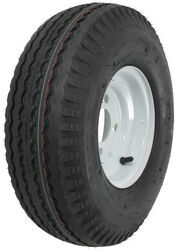
Studs Breaking on Dual Axel Boat Trailer
Question:
Hi, For the second time in 4 years I have had studs break off the driver side rear wheel on my trailer. By the time I am aware some are broke off the holes in the wheel have ovaled out, ruining the wheel all together. I’m trying to figure out why this might be happening. I know that over tightening the lugs can cause this, but I think it may be caused by the hard angle when parking in the garage to make it fit. I have to chock that tire prior to releasing the trailer from the truck so it stays put when I unhook the trailer. I’m sure there is a good amount of pressure there in that wheel. In other words when the boat is released from the truck all that pressure is transferred to that chocked wheel. I would think whichever studs are toward the front of the boat would bear a lot of pressure, just like if the lugs were over tightened? Maybe ratchet strapping the front of the trailer to the wall rather than chocking that tire would prevent this from happening again?
asked by: Rick K
Expert Reply:
The main reason for them breaking off is because there is too much torque on them or from having them to loose which then can create movement and eventually cause them to break. It is hard to say if the hard angle is making it to where your lugs break because of the amount of pressure being put on them.
Another possibility could be a reduction in the clamp force. This could be caused by rust or dirt. It is recommended to use a wire brush to remove any rust or dirt present on the mating surfaces of the wheel rim and the brake rotor or brake drum. If it is not done the corrosion or dirt that is tightened down will degrade over time leading to a soft joint. This will prevent movement between the rim and rotor, and if prolonged will cause of fracture of the wheel stud.
The final thing could be not re-torquing after driving some miles. Most wheel fitting shops recommend re-torquing you lugs nuts after driving some distance. The reason for this is related to the possible reduction in clamp force due to expansion or contraction of metals as a result of temperature. The recommended distance to go before re-torquing varies, but by source a lot of people say 50 miles.

Product Page this Question was Asked From
Kenda 5.70-8 Bias Trailer Tire with 8" White Wheel - 4 on 4 - Load Range C
- Trailer Tires and Wheels
- Tire with Wheel
- Bias Ply Tire
- Load Range C
- 5.70-8
- 8 Inch
- 4 on 4 Inch
- Steel Wheels - Powder Coat
- Kenda
more information >

Continue Researching
- Article: Trailer Tire Sizing
- Q&A: Installation Information for the Replacement Cables for Enclosed Trailer Ramp Spring # ERS160D96
- Article: Measuring a Trailer Tire
- Q&A: Difference Between ST205/75D15 and ST205/75R15 Size Tires
- Q&A: What is the Difference Between Load Range B and C Trailer Tires
- Article: Where to Position the Trailer Axle?
- Article: 7 Common Questions Everyone Has About Trailer Tires
- Q&A: Will Trailer Wheel with 2-1/2 Inch Pilot Hole Fit in Place of a Wheel with 2-3/4 Inch Pilot Hole
- Article: Most Popular Wheel Bearings
- Q&A: Reverse Lockout to Use with Demco Surge Actuator DA70
- Q&A: Can You Mix Different Load Range Tires On The Same Boat Trailer Axle
- Q&A: What Holds the Weight of a Trailer Wheel, the Studs or the Pilot Hole
- Article: How to Measure Your Trailer Wheel Bolt Pattern
- Article: Trailer Maintenance Schedule




